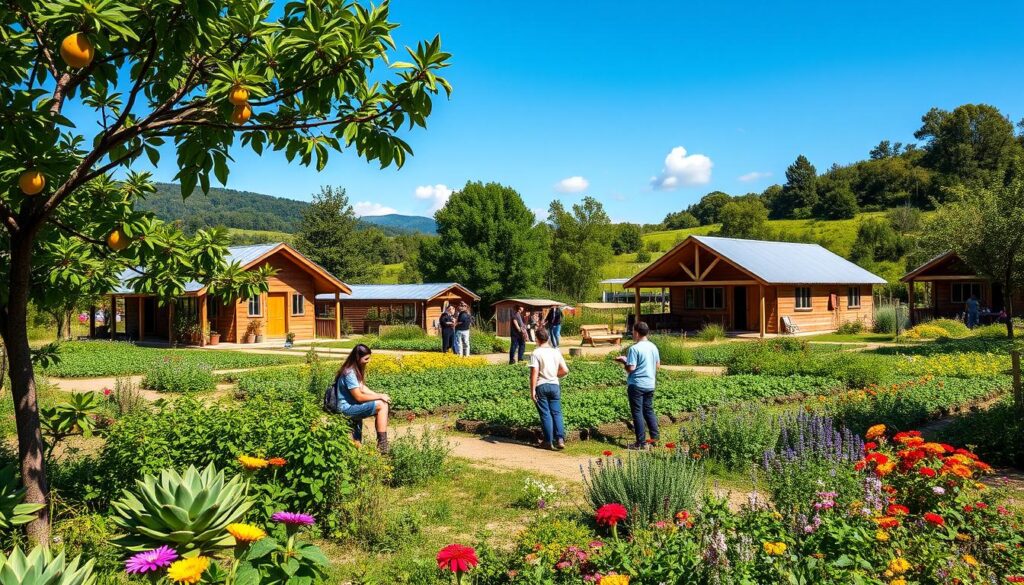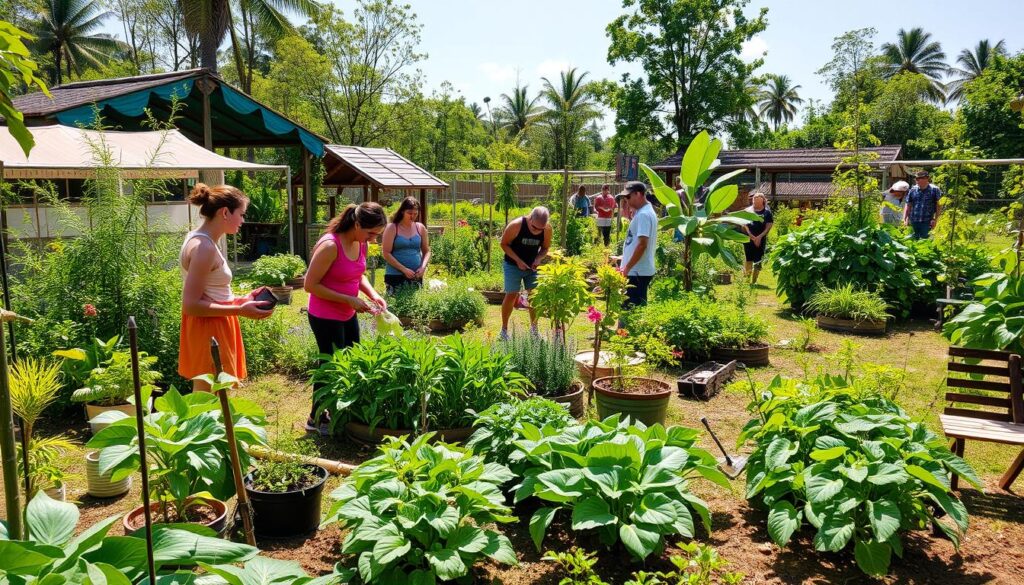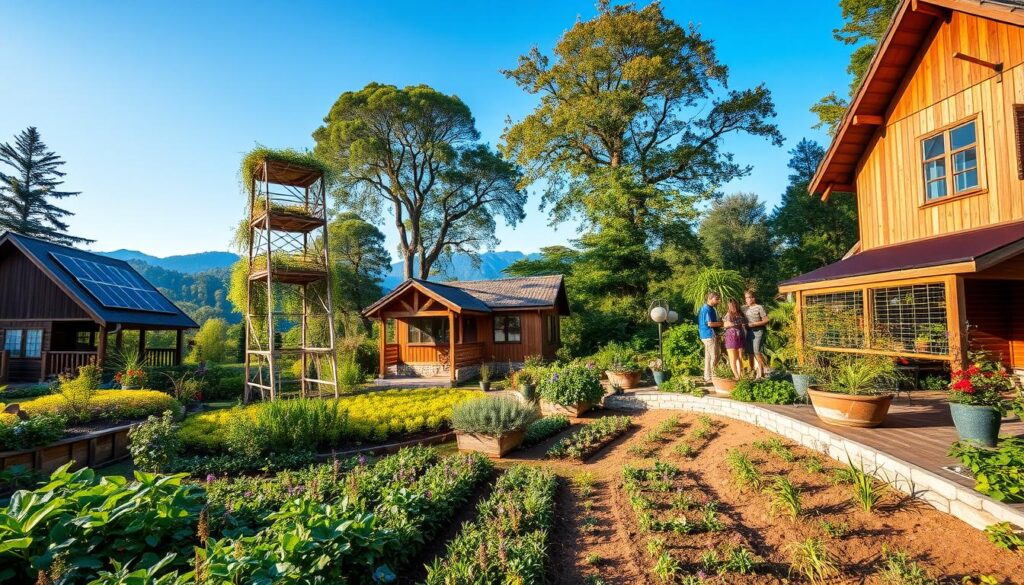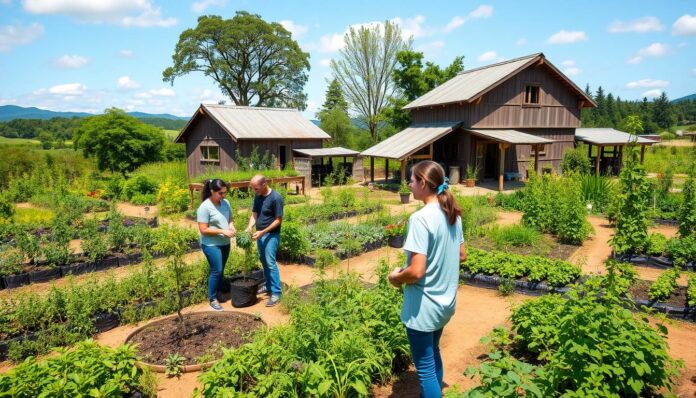What if the key to a sustainable and profitable tourism operation was in how staff interact with the environment? Permaculture tourism training is now key as more tourists and travel companies look for eco-friendly options. With permaculture tourism on the rise, training staff is vital for a unique and educational tourist experience. The online permaculture design course, with 14 modules, offers a detailed training program. It covers sustainable agriculture and eco-friendly travel workshops.
Training programs like the Level Up Permaculture online course bring many benefits. They include sustainable agriculture courses and eco-friendly travel workshops. These programs equip staff with the knowledge and skills for a sustainable and profitable tourism operation. As demand for permaculture tourism grows, training staff is key to offering a unique and educational experience.
Key Takeaways
- Permaculture tourism training is essential for creating a sustainable and profitable tourism operation
- Staff training programs, such as the online permaculture design course, provide comprehensive training in permaculture principles and practices
- Sustainable agriculture courses and eco-friendly travel workshops are key components of permaculture tourism training programs
- Permaculture tourism training programs, such as the Level Up Permaculture online course, offer a range of benefits, including increased staff knowledge and skills
- Permaculture tourism training is crucial in providing a unique and educational experience for tourists
- The online permaculture design course provides a range of interactive and educational resources, including animations and Q&A videos
- Permaculture tourism training programs can help tourism operations reduce their environmental impact and increase their profitability
Introduction to Permaculture Tourism
Permaculture was first used by Bill Mollison in 1978. It’s a way to grow food that’s good for the planet and doesn’t need much help. When we talk about tourism, permaculture makes travel better and greener. Getting a regenerative tourism certification shows a business cares about the environment.
Learning about nature and farming is key in permaculture tourism. These lessons teach us to protect the earth and its creatures. By using permaculture, businesses can lessen their harm to the environment and offer special experiences to visitors.
- Promoting sustainable agriculture practices
- Supporting local communities and economies
- Providing unique and educational experiences for tourists
More people want to travel in a way that’s good for the planet. Permaculture tourism is a great choice for those who want to help the environment. By focusing on regenerative tourism, nature education, and green farming, businesses can stand out and attract like-minded travelers.
Overview of Permaculture Principles
Permaculture is a design system that aims for sustainability in many areas, including tourism. It teaches us how to apply permaculture in tourism. Training programs help develop the skills for sustainable tourism practices.
Principle One: Observe and Interact
This principle teaches us to observe and interact with nature. It helps us understand its patterns and relationships. By doing this, tourism operators can reduce their environmental impact.
For example, by observing wildlife, they can design tours that respect nature’s balance.
Principle Two: Catch and Store Energy
This principle is about catching and storing energy from the environment. In tourism, using renewable energy like solar or wind power is key. This reduces carbon emissions.
Organic tourism training programs teach how to implement these practices.
Principle Three: Obtain a Yield
This principle is about getting a yield from the environment without harming it. In tourism, it means using sustainable agriculture for food. This keeps the soil and ecosystem healthy.
By using these principles, tourism can be sustainable and efficient. It benefits the environment and local communities. Training programs provide the skills needed to achieve this.
| Principle | Description | Application in Tourism |
|---|---|---|
| Observe and Interact | Observing and interacting with nature | Developing sustainable tours that minimize environmental impact |
| Catch and Store Energy | Catching and storing energy from the environment | Using renewable energy sources to reduce carbon emissions |
| Obtain a Yield | Obtaining a yield from the environment without harming it | Developing sustainable agriculture practices that provide food for tourists |
Importance of Staff Training in Permaculture Tourism
Staff training is key in permaculture tourism. It helps employees give great customer service, work well together, and run things smoothly. By training staff, permaculture tourism can do better and last longer.
Permaculture tourism can get better with sustainable agriculture courses and eco-friendly travel workshops. These help staff learn about sustainable practices and give special experiences to guests. This knowledge lets staff help the operation stay green and achieve its goals.
Enhancing Customer Experience
Trained staff can make customers happy by giving them personal service and sharing their knowledge. They can also create unforgettable moments for visitors. This leads to happy customers who tell others and leave good reviews online.
Building Team Cohesion
Training staff helps them understand the operation’s mission and values. When staff are trained and confident, they work better together. This creates a positive and productive team environment.
Increasing Operational Efficiency
Trained staff can make things run more smoothly by cutting waste and using resources wisely. Training helps reduce costs and boosts productivity. This means more profit and a sustainable future for permaculture tourism.
Training Modules for Permaculture Tourism Staff
Permaculture tourism staff need thorough training to manage and run permaculture tourism well. They learn through holistic travel courses and nature-based tourism seminars. These help them understand sustainable practices better.
The training covers many topics. This includes sustainable farming, eco-tourism customer service, and safety and emergency plans.
Some important topics in these modules are:
- Sustainable agriculture practices, such as permaculture design and natural building
- Customer service in eco-tourism, including communication skills and conflict resolution
- Safety and emergency procedures, such as first aid and emergency response planning
The table below shows some key training modules and what they cover:
| Training Module | Description |
|---|---|
| Sustainable Agriculture Practices | Covers topics such as permaculture design, natural building, and renewable energy systems |
| Customer Service in Eco-Tourism | Covers topics such as communication skills, conflict resolution, and cultural sensitivity |
| Safety and Emergency Procedures | Covers topics such as first aid, emergency response planning, and risk management |

By taking part in these modules, staff can learn to manage permaculture tourism effectively. They also promote sustainable practices and reduce environmental harm.
Curriculum Development for Training Sessions
Creating a detailed curriculum is key for good training in permaculture tourism. It’s important to define learning outcomes that match the goals of regenerative tourism and green farming education. This way, participants can learn by doing, gaining practical skills in permaculture.
A mix of learning methods can make the curriculum effective. It should include lectures, discussions, and hands-on training. This way, participants get both theory and practical experience in green farming and regenerative tourism.
Some important parts of the curriculum are:
- Principles of permaculture and their use in tourism
- Green farming practices and their part in sustainable tourism
- Regenerative tourism certification and its good for local communities
By covering these topics, participants will understand permaculture tourism better. They’ll see how it helps in sustainable development and protecting the environment.
The curriculum can be taught in many ways, like online courses, workshops, and field training. Using a mix of learning methods and hands-on experience, participants will get the skills needed for permaculture tourism. They’ll help make tourism more sustainable and regenerative.
| Topic | Description |
|---|---|
| Permaculture Principles | Introduction to permaculture principles and their application in tourism |
| Green Farming Practices | Overview of green farming practices and their role in sustainable tourism |
| Regenerative Tourism Certification | Benefits and process of regenerative tourism certification |
Hands-On Learning and Field Training
Permaculture tourism training and organic tourism programs focus on hands-on learning. The Permaculture Design Course, for example, has over 100 hours of instruction. It includes hands-on projects about ecological systems. This way, students get to really understand the material by doing it.
Practical experience is key in permaculture tourism training. The UVM Farmer Training Program mixes hands-on learning with classroom lessons and field trips. It covers over 30 topics on sustainable farming. This helps students grasp permaculture principles and how to use them in real life.
- Practical experience with organic crop production and small-scale farm management
- Hands-on learning with water harvesting, community building, and soil building
- Opportunities for networking with professionals involved in sustainable agriculture and local community food systems
Benefits of Field Training
Field training lets students apply what they learn in real situations. It boosts their understanding of permaculture and its use. It also helps them develop skills like problem-solving and critical thinking, which are vital in permaculture tourism.
Designing Effective Field Training Programs
Good field training programs should mix hands-on learning with theory. The curriculum should cover a wide range of topics, like permaculture principles and community building. It should also offer chances for students to dive deep into the material.
Roles and Responsibilities of Trained Staff
Trained staff in permaculture tourism are key to its success. They handle everything from guiding visitors to managing where they stay. Their work ensures eco-friendly travel and sustainable agriculture courses run smoothly.
Some of the main tasks for trained staff include:
- Guides and educators: They share knowledge on permaculture.
- Hospitality and accommodation management: They make sure visitors are comfortable.
- Marketing and community engagement: They promote the operation and connect with locals.
These staff members are crucial for a great visitor experience. By taking part in workshops, visitors learn more about permaculture. This helps the operation succeed.
The work of trained staff is vital for permaculture tourism. Their efforts positively impact the environment and local communities.
| Role | Responsibilities |
|---|---|
| Guides and Educators | Providing information and guidance on permaculture principles and practices |
| Hospitality and Accommodation Management | Ensuring that visitors have a comfortable and enjoyable stay |
| Marketing and Community Engagement | Promoting the permaculture tourism operation and engaging with the local community |
Development of Training Materials
Creating effective training materials is key for permaculture tourism staff. It’s about making content that’s both fun and informative. Holistic travel courses teach staff about sustainable tourism. Nature-based tourism seminars focus on saving the environment.
Some important parts of training materials are:
- Interactive training manuals that teach permaculture basics
- Supplementary video resources that show off sustainable tourism efforts
- Case studies of successful permaculture tourism projects
These elements make training materials both useful and fun. They give staff the tools to offer top-notch permaculture tourism experiences. 
| Training Component | Description |
|---|---|
| Interactive Training Manuals | Cover permaculture principles and practices |
| Supplementary Video Resources | Showcase sustainable tourism initiatives |
| Case Studies | Highlight successful permaculture tourism projects |
Assessment and Evaluation of Training Effectiveness
Effective training in permaculture tourism needs ongoing checks to make sure everyone learns what they should. This means doing tests before and after the training and getting feedback all along. By adding regenerative tourism certification and green farming education to the program, learners get a better grasp of sustainable practices in tourism.
Pre- and Post-Training Assessments
Before the training, tests find out what learners know and what they need to learn. After, tests see if the training worked. These can be surveys, quizzes, or hands-on tasks. They show how well the training changed what learners know and do.
Continuous Feedback Mechanisms
Getting feedback all the time is key to seeing how learners are doing and where they need help. This can be through regular meetings, feedback from peers, and self-checks. Trainers can offer ongoing support to help learners stay on track and reach their goals. Important parts of this feedback include:
- Regular progress updates
- Peer review and feedback
- Self-assessment and reflection
Case Studies in Successful Permaculture Tourism
Permaculture tourism has been a hit in many places, including the United States. The Mesoamerican Institute of Permaculture (IMAP) is a great example. They offer permaculture tourism training programs.
These programs let people get hands-on with sustainable farming, eco-tourism, and helping communities grow. It’s a real chance to learn by doing.
The IMAP’s organic tourism training program is a big success. It teaches people about permaculture, soil care, and how to harvest rainwater. Plus, it lets them meet local people and learn about their culture.

- It’s all about working with and involving the community.
- It focuses on farming in a way that’s good for the planet.
- Teaching local people about permaculture tourism training is crucial.
By using these methods, permaculture tourism can help make travel better for the planet. It also helps local economies and communities. The organic tourism training program is a great example for others to follow.
Collaborating with Local Communities
Working with local communities is key for permaculture tourism to succeed. By teaming up with local groups and creating jobs, permaculture tourism helps the local economy grow. It also builds a strong community feeling. This is done through sustainable agriculture courses and eco-friendly travel workshops. These offer chances to learn and grow together.
Some good things come from working with local communities include:
- Enhanced cultural experiences for tourists
- Increased economic benefits for local residents
- Improved environmental sustainability through shared knowledge and practices
By working with local communities and offering sustainable agriculture courses and eco-friendly travel workshops, permaculture tourism helps the environment. It also supports the local economy. This makes tourism better for both the community and the planet.
Together, permaculture tourism can make a big difference in local communities. It also gives tourists unique and meaningful experiences. By focusing on eco-friendly travel workshops and sustainable agriculture courses, these operations help make tourism more sustainable and responsible.
| Benefits of Collaboration | Outcomes |
|---|---|
| Enhanced cultural experiences | Increased tourist satisfaction |
| Increased economic benefits | Improved local economy |
| Improved environmental sustainability | Reduced environmental impact |
Marketing Permaculture Tourism Training Programs
Marketing permaculture tourism training programs is key to draw in the right people. These programs teach about the connection between ecosystems and the need to protect nature. They also show how tourism can help conservation.
To market these programs well, you need to know who you’re talking to. Highlight the good things about these courses, like learning about the environment and meeting others who care. Use social media to spread the word and reach people all over the world. For more on sustainable tourism, check out permaculturepractice.com to see how permaculture helps animals on farms.

Here are some marketing tips for permaculture tourism training programs:
- Focus on what makes your program special, like hands-on learning and expert teachers.
- Point out the benefits of nature-based tourism seminars, like learning about the environment and helping conservation.
- Use social media to reach more people and share what your program offers.
With a smart marketing plan, permaculture tourism training programs can attract the right people. This helps grow the industry and protects our natural world.
Challenges in Training for Permaculture Tourism
The need for quality training in permaculture tourism is growing fast. Yet, several hurdles must be cleared for success. A big problem is the lack of regenerative tourism certification programs. This makes it hard for operators to show they’re committed to green practices.
Another issue is the need for green farming education in permaculture. This education is both time-consuming and expensive. A study on permaculture and its impact shows that lack of training is a big barrier. To tackle these problems, operators can team up with local experts and organizations.
Some ways to tackle these issues include:
- Creating training programs that meet the needs of permaculture tourism
- Offering hands-on learning and field training in permaculture
- Encouraging sharing of knowledge among operators, communities, and experts
By tackling these challenges and offering quality training, permaculture tourism can lead the way. It can promote green tourism, support local areas, and make the tourism industry more responsible.
Future Trends in Permaculture Tourism Training
The world is changing fast, and so is permaculture tourism training. The growth of online learning platforms is set to change how we learn. These digital tools make it easier for people to get top-notch training.
They offer flexibility and convenience, meeting the needs of many learners. This makes organic tourism training program more available than ever.
New approaches in eco-tourism training are also on the rise. We’re seeing things like virtual reality, interactive e-learning, and gamified learning. These new methods make learning fun and engaging.
They also prepare trainees for the fast-changing tourism industry. As more people want sustainable tourism, permaculture will play a big role. It will teach future professionals how to make tourism better for the environment and local communities.

